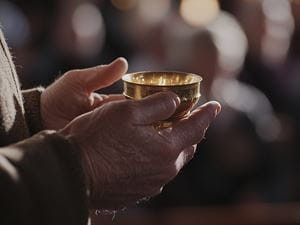
For any Game of Thrones fan, the phrase ‘chalice-bearer’ — that is, a lay person who serves Holy Communion — probably brings to mind ‘The Purple Wedding’ in Season Four. Joffrey Baratheon, you’ll recall, takes a goblet off Tyrion Lannister, his ‘cup-bearer’, and upends it over his head.
Fortunately, for my sake, the Lord of the Seven Kingdoms is not a parishioner of ours. I might’ve been in for a rough ride if he were; because for a while now (maybe six months), I’ve served as a chalice-bearer at Holy Communion in our church.
I feel magnetically drawn to the Mass, as a Christian, for its crucial place in our lives; and so, this was an opportunity that I jumped at, albeit with trepidation, whenever my priest asked me to get involved. It’s an honour, but a slightly terrifying honour, when your task is to help somebody meet with Christ.
What exactly, then, is involved in being a chalice-bearer?
Basically, the job is to follow the priest around while they hand wafers to the Faithful; after the parishioner has had a chance to swallow their bread, a chalice-bearer gives them wine. Other mini-rituals, like washing the hands of the priest before they touch the sacred elements, call for a chalice-bearer’s help, too.
St. George’s Church, Belfast, another congregation in our diocese, has detailed instructions for chalice-bearers on their parish website.
Reading over these, probably the most important one is: ‘Note that persons receiving communion have different preferences on how they take communion’.
There are, you could say, ‘dippers’ and ‘sippers’: people, on the one hand, who dip their wafer into the chalice; and people, on the other hand, who consume their wafer and then take a sip from the chalice. I’d say that you get about one dipper for every three sippers.
‘Calm poise and manner is the key to ensuring a good sacramental experience for the communicant’, reads another bit of advice. You’re not, I would paraphrase, a punter in some casual burger joint.
Everything is done with extreme care, mindful that what we hold is infinitely precious, and with empathy towards fellow believers; the latter point is especially true when we serve those with a physical ailment, who may need a little more time and space.
There’s a lot of other stuff to remember.
When items are not in use on the altar, they belong on a special table called a ‘credence’. This includes two flagons: a bigger one for wine and a smaller one for water.
Since you could accidentally wash the priest’s fingers with wine instead of water if you mix them up, it’s vital to remember which is which.
In the UK, we call someone who likes their drink a ‘big wino’, so there’s your way to remember what’s in the bigger flagon!
Thankfully, there is always a priest on standby to make sure you don’t make too many blunders; the craft of a priest is considerably more demanding, of course, than that of a chalice-bearer.
‘Priestcraft’ is a term that’s only really heard — if it’s heard at all, nowadays — in a derogatory tone (the way the most radical of radical Protestants might use it, for example).
But when you serve with a priest, you see the true sense in which priesthood is a craft: in the same way needlecraft is (a lot of dedication is needed in order to become fully proficient).
Holy Communion is a complex affair for any ‘catering team’ to handle; but it’s a pleasure to do so. Normally, the catering staff at a venue don’t partake in the meal; your waiter doesn’t usually stride over to your table and skull your drink in one go.
Fortunately, chalice-bearers (and priests) are both guest and server; we’re both recipients of God’s grace and agents of it.
‘Lord, I am not worthy to receive you, but only say the word and I shall be healed’, we read from the Prayer Book (before the celebrant receives communion); and it’s this phrase, borrowed from the Gospel of Matthew, that encourages us to view the sacrament as our spiritual medicine.
Perhaps, then, we chalice-bearers are the spiritual pharmacists or nurses of a parish; we don’t actually make the ‘medicine’ (a priest or bishops does this), but we distribute it, instead, to the sick in body, mind or soul.
It’s a real privilege to be able to do this.
Before I close this laptop and iron a surplice for Sunday’s Holy Communion (once you’ve ironed a surplice, you’ll never complain about ironing anything else), I’ll offer you this last reflection: when you serve Holy Communion – and you see face after different face, all bowed low before God’s altar – it underlines for you, like never before, the reality that all are equal before God; whomever those faces belong to – men or women, old or young, rich or poor – the Blessed Sacrament unites us all in one body: that of Our Lord, who looks upon us with boundless love.
2/10/2025 5:58:19 AM





